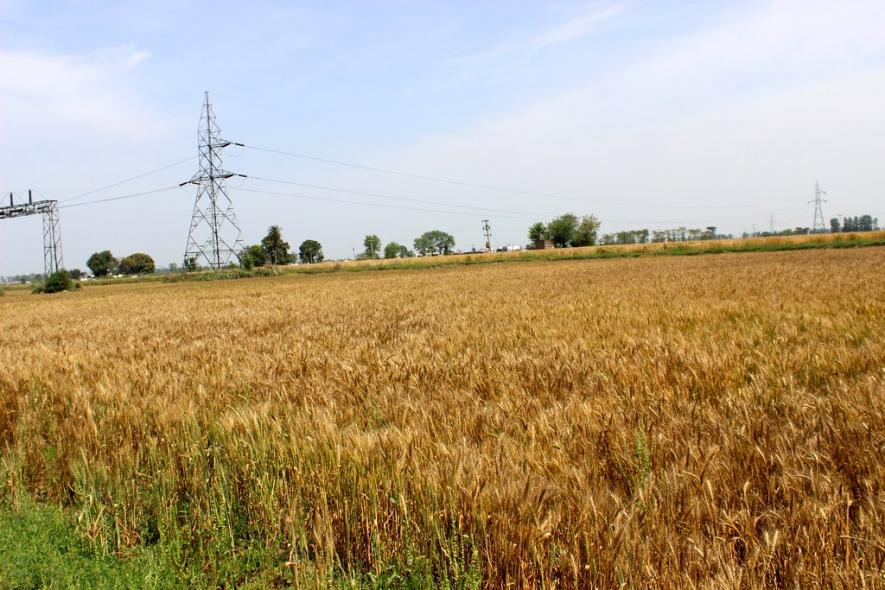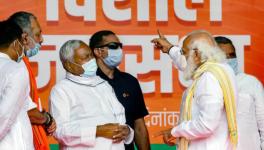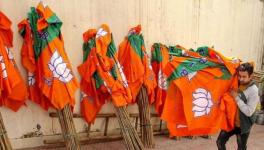COVID-19 in Rural India-XXI: Agriculture takes a Battering in Bihar’s Buxar

Representational Image
This is the 21st report in a series that provides glimpses into the impact of COVID-19-related policies on life in rural India. The series, commissioned by the Society for Social and Economic Research, comprises reports by various scholars who have been conducting village studies in different parts of India. The reports have been prepared on the basis of telephonic interviews with key informants in their study villages. This article talks about how the lockdown has affected the primarily agricultural district of Buxar in Bihar, where returning migrants face suspicion while farmers struggle to sell their Rabi crop and prepare for next season.
The villages of Murarpur, Chandudehara and Garahiya lie in two adjacent blocks, Itarhi and Nawangar, in Bihar’s Buxar district. While the former two are in the Itarhi block and adjacent to each other, Garahiya is in the Nawanagar block. The two blocks of Itarhi and Nawanagar form part of the alluvium tract in the region and are the southern blocks of the district. Itarhi has 160 villages and fifteen panchayats within its boundaries whereas Nawanagar has 104 villages and sixteen panchayats.
As is the case with much of Bihar’s interiors, this district has seen very little urbanisation. The share of urban population in the district is only about 9.7% and out of eleven blocks in the district, nine are completely rural with not a single town. These rural blocks have similar physicality and economic activities. Unsurprisingly, agriculture is the major economic activity here, with cereals and pulses the main produce.
Buxar district is the major wheat producer in the state and its net sown area accounts for 82.7% of its total geographical area as of 2012-13 (Directorate of Economics and Statistics, Economic Survey Report 2015-16, GoB). However, since the lockdown began, there are not many non-farm employment opportunities in the villages. MNREGA-related work had been taking place in Murarpur and Chandudehara but that stopped as well.
The state of agriculture
Unlike several other economic activities, agriculture requires workers to leave their homes, and the work is seasonal in nature. During the Rabi season, wheat is the main crop, but mustard, potato, pulses and peppermint are also grown. At the beginning of April, the standing wheat and mustard crops were ready for harvest while pulses like gram and masoor had been damaged owing to excessive, untimely rains which lasted until mid-March. Farmers said that gram and pulses from this season had been affected and that there was no surplus for them to sell. They were contemplating harvesting the wheat crop in the first week of April since any delay in the harvest would affect preparation for the next season.
In recent years, peppermint is the only cash crop that is cultivated during this season but it is grown on a smaller scale in only a small portion of landholdings, especially among the big landholders. After the wheat harvest, the fields are burnt and left fallow until preparations for the next crop begin. The district follows a two-crop pattern of cultivation, harvesting wheat and rice in the Rabi and Kharif seasons respectively, along with pulses, oilseeds and potato.
Harvesting the Rabi crop
Harvesting of wheat in this part of the country is nearly entirely mechanized; both landowners and tenant farmers, independent of land holding depend on mechanical harvesting and threshing. Every panchayat has a certain number of harvesters owned by local landlords; these are usually hired out during this time. Crucially, the machine operators which include drivers, technicians and repair men come from Punjab during this season, and the owners of the machines are responsible for recruiting these workers. Due to the lockdown, these workers have not yet arrived in Bihar, which has delayed the wheat harvest. This is a matter of some concern.
Meanwhile, some farmers had begun manual harvesting of the mustard crop with women workers. The wages for this kind of job are about one-tenth of the total crop harvested.
Storage of crops
Even if the wheat is eventually harvested, despite the delays, the other big challenge for farmers is storing it. Storage facilities help farmers sell at a later date and get better prices but the farmers complained that the authorities have not paid enough attention to the major issues of harvesting and storage. There is no storage infrastructure at the village, panchayat or at the block level. The warehouses and PACS godowns are at a distance of between ten to fifteen kilometres from these villages while the district headquarters is further away, about 30 kms or more—all of these are difficult or impossible to access during the lockdown, with no transport available. While some of the bigger landholding households can manage to store the crop in their homes, small and marginal farmers have no way out. Local sales are also not possible at this time.
The financial crunch
The lockdown has created an uncertainty about how and when the crop will be sold. Although the Minimum Support Price (MSP) of wheat has been decided by the government, farmers have been unable to sell their produce. A big farmer in Murarpur said, “the MSP has been decided by the government at Rs 1,800 per quintal of wheat, but where are buyers during a lockdown? The government has not announced anything about this and we need the money,” he added.
As is the case generally, local baniyas purchase grain from the villages and take it to the procurement centre and elsewhere, but they have been unable to do so during the lockdown. Farmers need cash to purchase inputs and make preparations for the next season. Marginal landholders or tenants, engaged in agriculture on land they have leased for the purpose, need money in the short term to pay rent.
When asked about cash withdrawal facilities in rural Bihar, farmers said that the Bank Mitra Kendra in the panchayats (a subsidiary unit of the Madhya Bihar Grameen Bank) is functional, but allows for withdrawals up to only Rs 5,000, while no new deposits can be made. However, important transactions under government schemes are facilitated for account holders of the Grameen Bank.
Dairy and livestock
Most livestock owners used to supply milk and dairy products to the nearest dairy collection units in small market centres and to the district town. This supply chain has been largely disrupted during the lockdown. For instance, a farmer and livestock owner in Garahiya village said that “around fifty kg of cottage cheese was supplied from our village to the nearest market of Sikraul on an average on a daily basis, which has now completely stopped due to the lockdown. and milk is also not being regularly supplied to collection units”.
He added that during the lockdown period, “the milk produced is left for self-consumption by households and there is no source of income”. In other words, despite the sale of dairy products being categorised as an “essential service”, there has been a near complete cessation of milk collection from the village for sale in nearby markets. With regard to fodder, there seems to be enough at the moment and, with the upcoming harvest, shortage of fodder is not a concern.
Interventions by the District Administration
When asked about the district administration and the other local authorities’ interventions on these issues, a farmer from the Nawanagar block said: “A farmers’ group with people from several village panchayats approached the district administration in wake of the lockdown regarding permission to hire staff from Punjab to operate harvesters for harvesting the standing wheat crop in the fields. We wrote to the magistrate about this issue as harvest time is near,” he added.
After a few days, the district administration issued a circular that allowed the farmers’ group or owners of the harvesters to obtain passes that would allow them to use their own vehicles to travel to Punjab and get the machine operators. However, given the costs and even otherwise, this is a very expensive proposition. With no other option left to them however, the farmers are willing to do this to alleviate the trying circumstances they are in.
In order to reign in prices and to prevent shopkeepers from hoarding and inflating prices, a list of the permitted maximum retail prices of essential commodities was released by the Zila Parishad. To some extent, this was effective to some extent in the first week of the lockdown. Thereafter, however, the prices of essential food items were solely decided by the sellers. The announcement of the central government regarding the supply of rations at the minimal rate will have limited impact for households that do not have ration cards. In any case, previous surveys in the village have shown that there appears to be substantial leakage in the Public Distribution System in the district.
Returning Migrants
Bihar is one of the largest sources of outward migration in the country. Since the announcement of the lockdown, the state is faced with a huge influx of returning migrants. The district of Buxar borders Uttar Pradesh on the west and migrants, especially from the Delhi-NCR region enter through this corridor. There are check-posts at the district borders with Uttar Pradesh at various points and screening of incoming people is taking place. The district administration then places returning migrants in quarantine facilities that are mostly public schools in the district town and in some villages. For instance, four migrant workers returned to Chandudehara village after walking a large part of the about 950 km-long journey from Delhi. On their arrival, they were quarantined for fourteen days at the Kaithna High School. Rural folk, who have become aware of the pandemic and its transmission, are readily informing the local authorities of any new arrivals in order for them to be isolated.
The pandemic is also redefining caste and class boundaries in many ways. Untouchability continues to exist in different forms among different castes in these villages but the pandemic has redefined the phenomenon as happening within the same caste and families as well. Migrants have returned face social stigma and hostility from their neighbours, and even their own families. Villagers see those who are coming from other states as a threat as they may be potential carriers. Migrants’ families are not letting them enter their houses and requesting the authorities to quarantine them in facilities elsewhere.
Dipti is an M.Phil-PhD scholar at the Tata Institute of Social Sciences.
Get the latest reports & analysis with people's perspective on Protests, movements & deep analytical videos, discussions of the current affairs in your Telegram app. Subscribe to NewsClick's Telegram channel & get Real-Time updates on stories, as they get published on our website.























